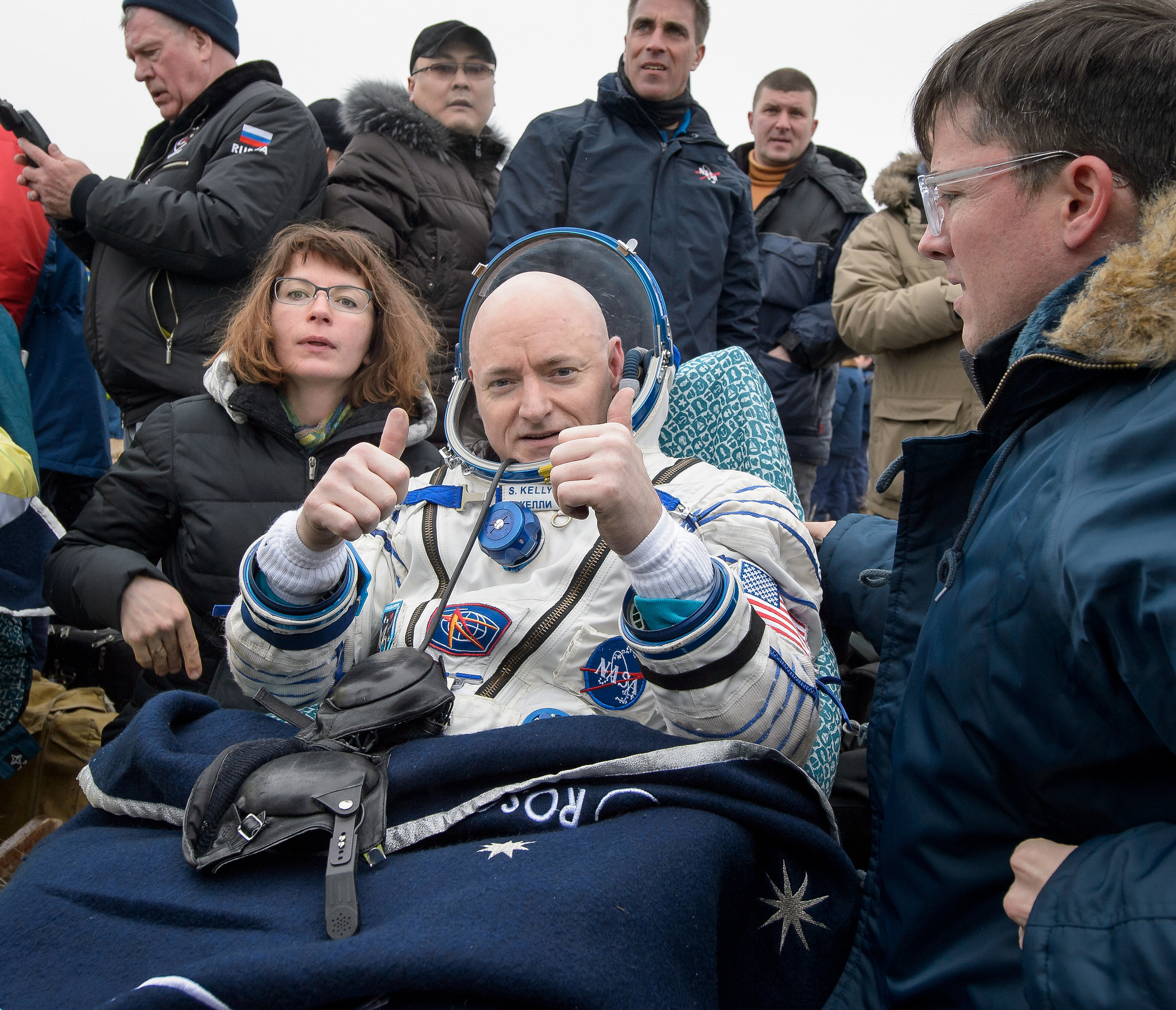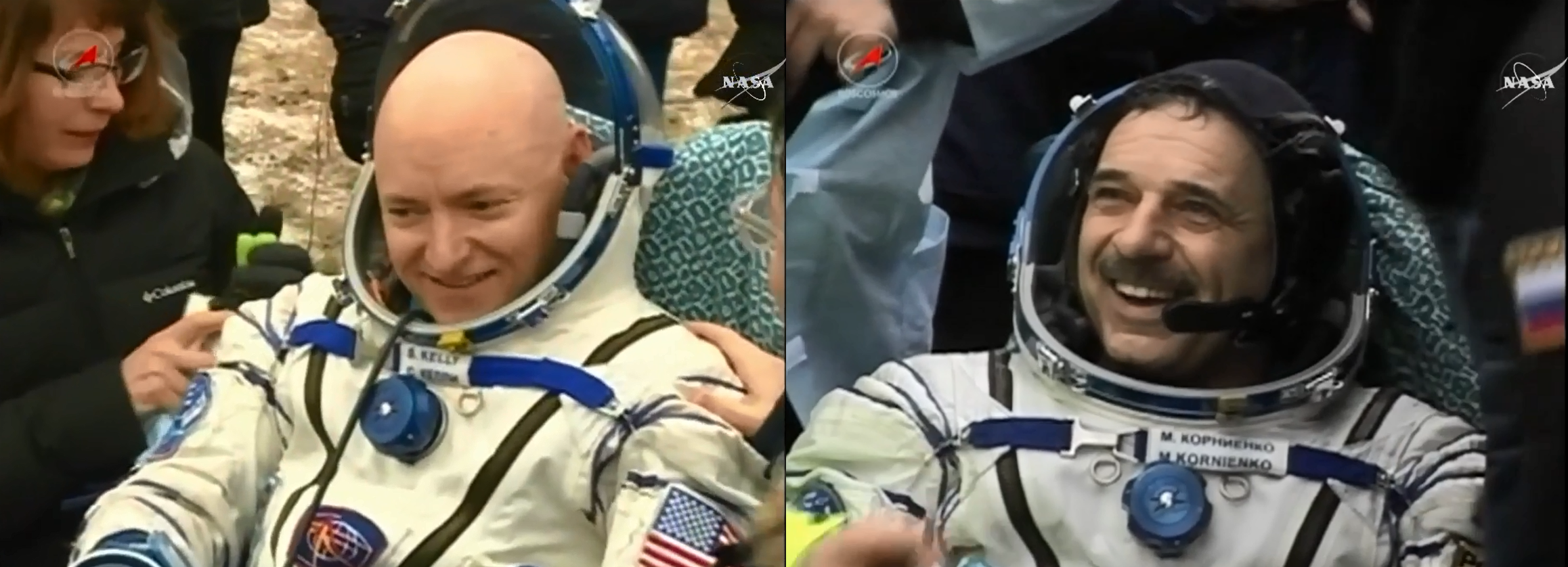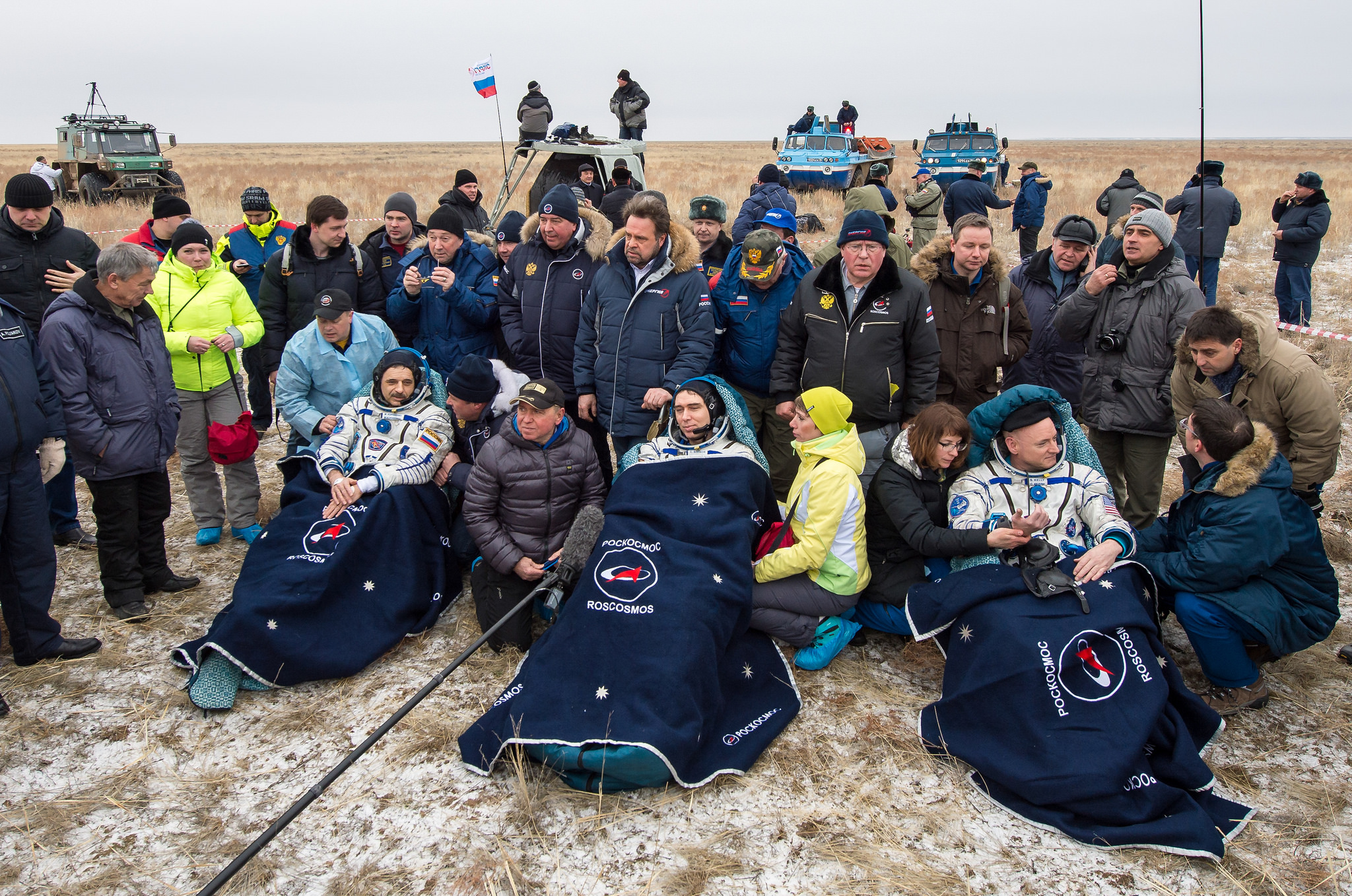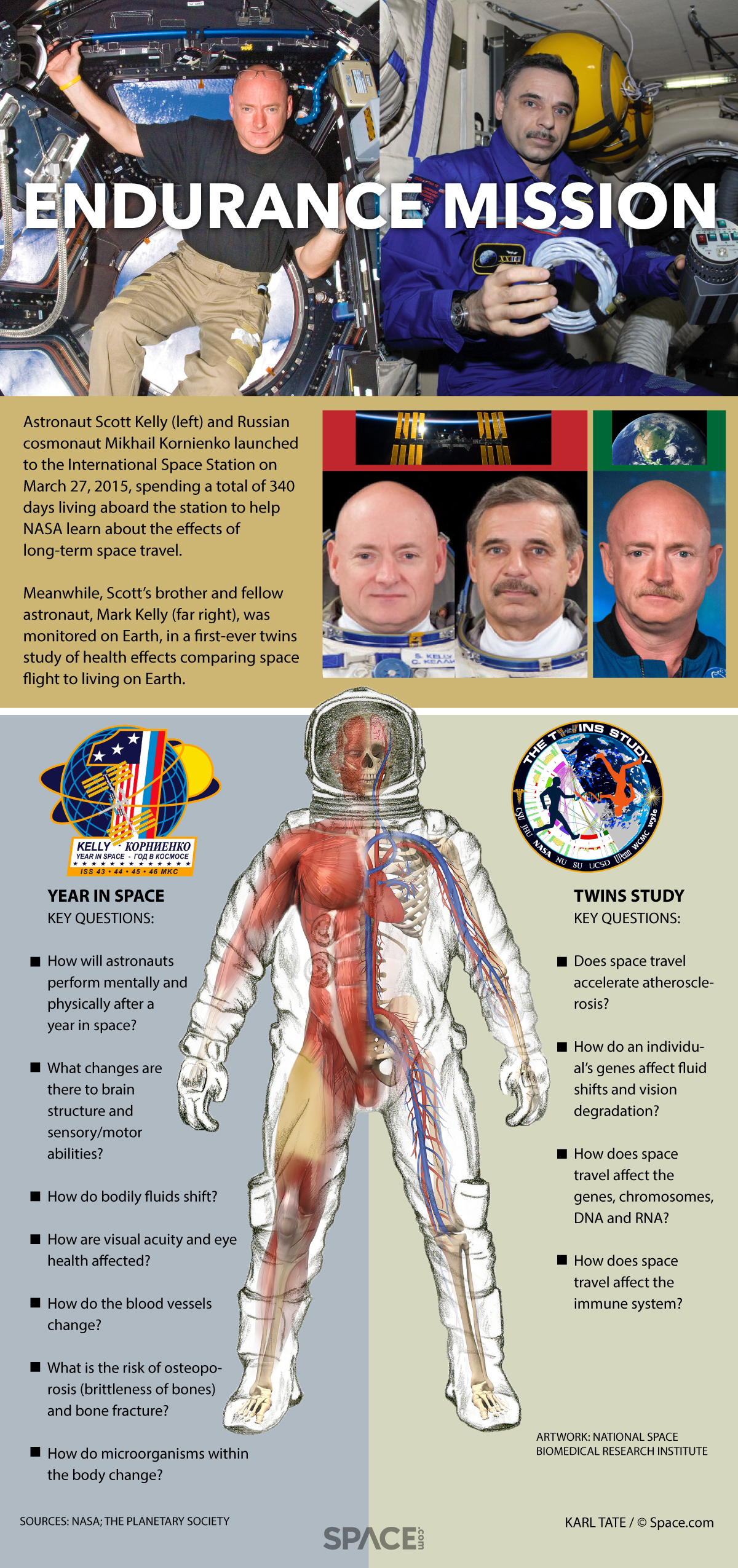After Nearly a Year in Space, Astronaut and Cosmonaut Return to Earth

Houston, they're back. After a yearlong mission to the International Space Station, a NASA astronaut and his Russian crewmate have finally returned to their home planet.
Kornienko and Kelly spent a whopping 340 days on the space station during their yearlong flight. Volkov arrived at the station last September, for a total of 182 days. During their flight, Kelly and Kornienko blasted past the record for longest stay on the International Space Station as an experiment (although Soviet-era cosmonauts spent longer on the Mir space station). [Welcome Home! Landing Photos of the One-Year Space Crew]
American astronaut Scott Kelly and Russian cosmonauts Mikhail Kornienko and Sergey Volkov landed safely in a remote part of Kazakhstan late Tuesday after more than three hours' travel from the space station. The trio landed in their Soyuz capsule at 11:26 p.m. EST (042 GMT), though it was well into Wednesday morning local time at their landing site.
"They did it — they're home after a year in space, and they stuck the landing," NASA spokesman Rob Navias said from the landing site. "It was a bullseye touchdown for the yearlong crew of Kelly and Kornienko and their Soyuz commander Sergey Volkov."
According to Navias, Kelly said: "The air is great up here," as he breathed in the landing site's frigid air. "I have no idea why you guys are all bundled up!"
The goal for the U.S.-Russian space team was to study how extended spaceflight affects the human body, using it as research for future long-duration trips, like a journey to Mars. With the duo now back on Earth, the real investigative work begins.

Their year in space
Over the past year, Kelly and Kornienko have shared the space station with 13 other astronauts — a rotating cast of co-investigators aboard the orbiting laboratory. While there, Kelly has sampled space veggies and coaxed zinnias to bloom in weightlessness, walked in space three times and endured two failed cargo ship delivery missions. He's taken part in experiments to characterize microgravity's effect on eyesight, measured sound, configured minisatellites and worked on many of the nearly 400 science studies investigating the world from space. [The Human Body in Space: 6 Weird Facts]
Get the Space.com Newsletter
Breaking space news, the latest updates on rocket launches, skywatching events and more!
And Kelly has documented our Earth informally, as well: His photographs have become a mainstay on Twitter and Instagram, where he would call out locations he was passing over and capture phenomena like thunder snow and spectacular auroras.

They didn't go anywhere new — besides sailing more than 17,000 mph (27,359 km/h) around the Earth — but the one-year astronauts are still explorers pushing the frontier of what we understand about the human body in space. (And the human mind, with five behavioral health investigations that examined cognitive performance, sleep, brain structure, emotion and fatigue.)
Kelly carries particular distinction in that area: besides comparing his physiology in detail to measurements from before he left, he will also be compared genetically to his identical twin brother, retired astronaut Mark Kelly, to see the toll spaceflight takes on the genome compared to staying home.
The journey home "is always bittersweet, when you leave this incredible place," Kelly said at the change-of-command ceremony on Monday, where he turned control of the station over to NASA astronaut Tim Kopra. "My friend Misha [Kornienko] here and I have been up here for a really, really long time, and recently we've been joking with each other, we'll say something like 'We did it' or 'We made it,' but we both recognize that this is a lot more about teamwork and all the people that it takes to put these missions together and be successful than it is about us."
"I want to thank everyone on the ground, first, that dedicated in some cases their lives, their working lives to this program; they are just as important to this endeavor, to our future going to Mars someday, as Misha and I," he added. [By the Numbers: Scott Kelly's Year in Space]
On the move
Kelly, Kornienko and Volkov spent much of their last day in space taking final science measurements and preparing for their departure, and said their farewells to the rest of the crew — Kopra, British astronaut Tim Peake and Russian cosmonaut Yuri Malenchenko — before getting into the Soyuz spacecraft and closing the hatch at 4:43 p.m. EST (2143 GMT). After the big goodbye they stuck around another three hours putting on their launch and entry suits, pressurizing the craft and checking for leaks in the hatch, suits and descent module.

With Volkov in the pilot's seat, the spacecraft, separated from the space station at 8:02 p.m. EST (0102 on March 2 GMT) and orbited Earth more than twice as Volkov maneuvered into position, shed the orbital and instrumentation/propulsion modules and then finally brought the crew down to Earth.
The astronaut and cosmonauts were scooped up by a Russian recovery team and brought to a portable tent for field tests, where scientists monitor them as they perfor simple tasks — standing up, walking in a straight line or around obstacles, remaining standing for three minutes — that may not be so simple after such a long time in space, NASA officials said in a statement. The trio will repeat those tasks three times within a day of landing and multiple times later on, to monitor their recovery, which will likely be much more difficult for Kelly and Kornienko.
"All this is designed to better understand how we can expect crewmembers to react and function after being in microgravity for such a long period of time," NASA spokesman Dan Huot said. Here on Earth we have a recovery team, he said, but new arrivals on Mars won't be so lucky: these tests will help us "understand what we can ask of our crewmembers when they do first take their first steps on the red planet just minutes after touchdown."
But these explorers are back on Earth, which means they can head to civilization. The trio will be flown back in three helicopters for a brief welcome ceremony and then go their separate ways. Finally, approximately 24 hours from now, Kelly will make it back home in Houston.
"I'd like for the legacy of this flight to be that we can decide to do hard things, and hard things that will take us farther away from the Earth, and this is one of them," Kelly said during a press conference from space Thursday (Feb. 25). "I'm hopeful, and I think we'll learn a lot about longer-duration spaceflight and how that will take us to Mars someday. So I'd like to think this is another of many steppingstones to us landing on Mars sometime in our future."
Email Sarah Lewin at slewin@space.com or follow her @SarahExplains. Follow us @Spacedotcom, Facebook and Google+. Original article on Space.com.
Join our Space Forums to keep talking space on the latest missions, night sky and more! And if you have a news tip, correction or comment, let us know at: community@space.com.

Sarah Lewin started writing for Space.com in June of 2015 as a Staff Writer and became Associate Editor in 2019 . Her work has been featured by Scientific American, IEEE Spectrum, Quanta Magazine, Wired, The Scientist, Science Friday and WGBH's Inside NOVA. Sarah has an MA from NYU's Science, Health and Environmental Reporting Program and an AB in mathematics from Brown University. When not writing, reading or thinking about space, Sarah enjoys musical theatre and mathematical papercraft. She is currently Assistant News Editor at Scientific American. You can follow her on Twitter @SarahExplains.









